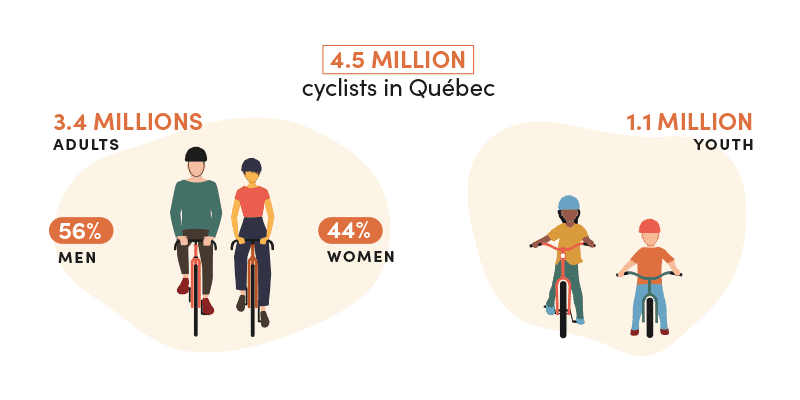Every 5 years since 1995, Vélo Quebec has carried out a major study, Cycling in Québec, a flagship publication of the organization. The Labrecque-Pronovost duo launched this initiative in the wake of the Québec government’s first cycling policy. Their goal was to profile biking and establish a benchmark for measuring the progress of this policy. Twenty years later, Cycling in Québec is still a vital reference tool for decisionmakers, researchers and activists.
Unsurprisingly, the profile of 2020 is atypical. Due to remote working and confinement, all modes of travel experienced a decline. At the same time, the past year was also marked by a major influx of new cycling enthusiasts eager to get moving and enjoy nature. All things considered, biking has gained ground and the number of cyclists in Québec is on the rise. Today, 4.5 million Quebecers go biking, 2.7 million of whom every week. Here are some elements that particularly caught my attention in this report:
- Since 1995, the number of cyclists over 55 has nearly doubled, from 23% to 42%, which is excellent news. It is interesting to note that, regardless of age, biking plays a key role in maintaining a healthy, active lifestyle, and that more and more people are making it part of their daily activities. Given the growing popularity of e-bikes, the future looks promising, since this will help prolong the cycling career of people of all ages.
- More and more people are opting to bike off pavement. It is estimated that 1.1 million cyclists use gravel roads, forest paths and trails specifically developed for mountain biking. Moreover, the study indicates that some 660,000 Quebecers have made mountain biking part of their recreational activities, since Québec has about 2,600 km of trails, 575 km of which in the Capitale-Nationale region alone. The growth of this sport and the latest numbers confirm that mountain biking is also gaining momentum and that we must further support its expansion in the coming years.
- You catch more flies with honey than with vinegar. Today, 61% of bike trips take place within a bike network. Quebec has over 10,600 km of bike paths. This network definitely helps make biking safe. Collisions have been on a downturn since 2015, with an overall decrease of 34%. There is a strong demand for bike paths. Seven out of ten people would like to see their municipality’s network extended. It should be noted that 62% of Quebecers live in a city with a sustainable mobility plan, including a cycling component. In anticipation of the upcoming municipal elections, several numbers would merit consideration in developing the candidates’ platforms.
More than ever, the collection of reliable data is essential for building public policies promoting a better quality of life for all. Unfortunately, the Canadian census and regional origin-destination surveys are not adapted to accurately measure modes of active travel like biking and walking. The publication of Cycling in Québec every 5 years is a step in the right direction in terms of showing public authorities the importance of the growth of cycling and the merits of planning infrastructures to encourage this activity for the good of our society.
Jean-François Rheault
President and CEO


